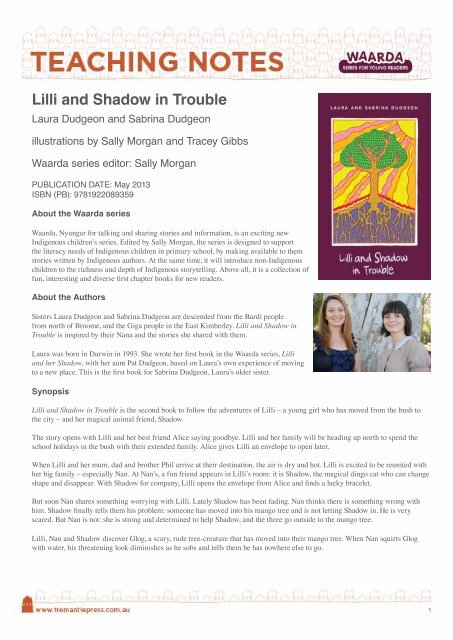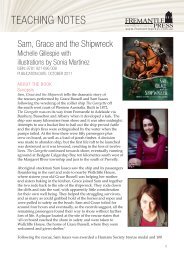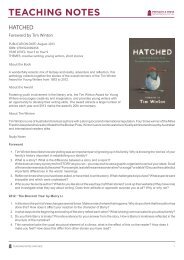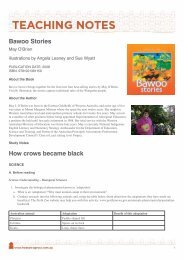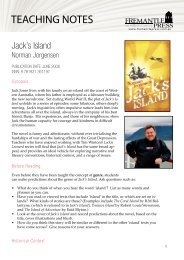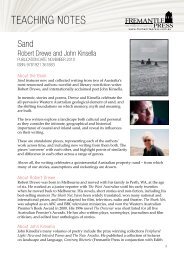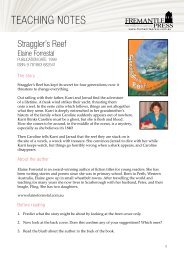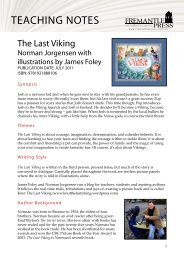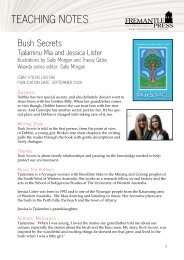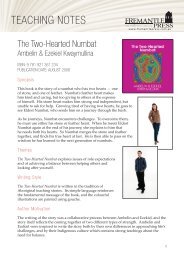LILLI AND SHADOW IN TROUBLE TEACHING ... - Fremantle Press
LILLI AND SHADOW IN TROUBLE TEACHING ... - Fremantle Press
LILLI AND SHADOW IN TROUBLE TEACHING ... - Fremantle Press
- No tags were found...
You also want an ePaper? Increase the reach of your titles
YUMPU automatically turns print PDFs into web optimized ePapers that Google loves.
Lilli and Shadow in TroubleLaura Dudgeon and Sabrina Dudgeonillustrations by Sally Morgan and Tracey GibbsWaarda series editor: Sally MorganPUBLICATION DATE: May 2013ISBN (PB): 9781922089359About the Waarda seriesWaarda, Nyungar for talking and sharing stories and information, is an exciting newIndigenous children’s series. Edited by Sally Morgan, the series is designed to supportthe literacy needs of Indigenous children in primary school, by making available to themstories written by Indigenous authors. At the same time, it will introduce non-Indigenouschildren to the richness and depth of Indigenous storytelling. Above all, it is a collection offun, interesting and diverse first chapter books for new readers.About the AuthorsSisters Laura Dudgeon and Sabrina Dudgeon are descended from the Bardi peoplefrom north of Broome, and the Giga people in the East Kimberley. Lilli and Shadow inTrouble is inspired by their Nana and the stories she shared with them.Laura was born in Darwin in 1993. She wrote her first book in the Waarda series, Lilliand her Shadow, with her aunt Pat Dudgeon, based on Laura’s own experience of movingto a new place. This is the first book for Sabrina Dudgeon, Laura’s older sister.SynopsisLilli and Shadow in Trouble is the second book to follow the adventures of Lilli – a young girl who has moved from the bush tothe city – and her magical animal friend, Shadow.The story opens with Lilli and her best friend Alice saying goodbye. Lilli and her family will be heading up north to spend theschool holidays in the bush with their extended family. Alice gives Lilli an envelope to open later.When Lilli and her mum, dad and brother Phil arrive at their destination, the air is dry and hot. Lilli is excited to be reunited withher big family – especially Nan. At Nan’s, a fun friend appears in Lilli’s room: it is Shadow, the magical dingo cat who can changeshape and disappear. With Shadow for company, Lilli opens the envelope from Alice and finds a lucky bracelet.But soon Nan shares something worrying with Lilli. Lately Shadow has been fading. Nan thinks there is something wrong withhim. Shadow finally tells them his problem: someone has moved into his mango tree and is not letting Shadow in. He is veryscared. But Nan is not: she is strong and determined to help Shadow, and the three go outside to the mango tree.Lilli, Nan and Shadow discover Glog, a scary, rude tree-creature that has moved into their mango tree. When Nan squirts Glogwith water, his threatening look diminishes as he sobs and tells them he has nowhere else to go.1
They resolve to help Glog, whose old tree home in the mangrove swamp has gone. While Nan thinks, Lilli gives Glog the luckybracelet from Alice to help him. Then Nan announces: they must find Glog a new mangrove home so Shadow can return to his mangotree.Uncle Bernie drives them all to Willi Creek, where they share a picnic. Among the mangroves, Glog finds a new tree that is notalready occupied. Everyone is happy with the solution, and Glog gives Lilli two beautiful shells – one for her and one for Alice – bywhich to remember their adventure.ThemesSocial behaviour, respect and consideration – The book emphasises the need to respect and consider others. Antisocial andintimidating behaviour is shown to be unacceptable, and is answered with firm but kind action. The story leaves room for thecharacters to change as they take time to listen to each other.Conflict resolution, dialogue and cooperation – The book shows that the best outcomes are achieved when we work together towards acommon goal. It demonstrates the importance of talking in order to understand each other and the need to find creative solutions thatbenefit the whole group.Friends, family and elders – The story highlights the role friends and family can play in solving problems. It shows that sharingour predicament with a trusted person gives us a better chance at resolving it. It also shines light on the valuable knowledge andexperience of senior members of society.Writing StyleThe story is written in the past tense and in the third-person point of view. There is a limited number of characters, making it astraightforward story for younger readers to manage and follow.The frequent use of dialogue moves the story forward and gives readers insight into the thoughts and feelings of multiple characters.Dialogue can be useful for children who are learning to read aloud as they can be encouraged to experiment with voice and expressionto make the story more interesting.Each chapter is well supported by illustrations which help maintain comprehension through the longer text. The use of chapter titleswhich reflect the events of each chapter can be used as a prompt to help less confident readers keep track of the story in their memoryas they read.Study NotesStructure and presentation1. After reading the story, reexamine the cover illustration and answer the following:a. Which elements of the story are illustrated on the cover?b. Why do you think the cover illustrator, Sally Morgan, chose to paint those elements?c. Draw your very own version of the book’s cover.2. Write an alternative back-cover blurb for the story.3. How important are the internal illustrations to your understanding of the story?4. The story is told in the third person, but principally from Lilli’s point of view. How might the story have been different if it weretold from the point of view of Alice, Nan, Shadow or Glog? Choose one chapter and rewrite it from the perspective of one of theother characters.5. Why do you think the story is divided into chapters? How do the chapters usually begin and end?2
Character development6. On page 28, Glog is described as a hairless creature that resembles a twisted old tree stump with a head, long thin grey gnarlyarms and legs, and dry grey eyes. As a class or in groups, discuss:a. What is your perception of Glog from his outward appearance?b. Does Glog’s outward appearance reflect who he is on the inside?c. How does Glog’s behaviour change throughout the course of the story?d. How do Lilli’s feelings towards Glog change throughout the story?e. Why did Glog give Lilli the shells?f. Draw your very own version of Glog.Conflict resolution7. Discuss the term ‘conflict’ as a class.a. What does it mean?b. What are some examples of conflict? Describe specific situations that can cause conflict at school, at home, within familiesand between nations. You can also give examples of ‘internal conflict’ – where one person struggles with contradicting viewswithin herself/himself.c. What is the source of conflict? Why is it that different people can see/experience a situation differently? Is it possible for twosides to be right at the same time? Discuss with reference to examples.d. Discuss possible ways to approach conflict, based on the examples mentioned in class so far. What responses will lead towardsresolution? What responses will make the conflict escalate?e. Is the same response always the best one, or does it depend on the situation? Explore examples of when another approach maybe more effective.8. Now consider the conflict in Lilli and Shadow in Trouble.a. Why did Shadow keep his problem to himself?b. How did Nan and Lilli get him to share his problem?c. What was Nan’s reaction to Shadow’s problem? What was Lilli’s? Why were they different?d. When Glog is first confronted, how does he behave? Why?e. How does Nan respond to Glog’s anger? Then, how does she respond to his crying? What steps does she take to find a solution?f. What does Lilli do while Nan is thinking? How is this important?g. Who else helps resolve the conflict?9. Write about a time when you successfully resolved a conflict, and how you achieved this.The environment10. As a class, discuss:a. What did the mangrove forest in which Glog lived protect?b. What impact did the destruction of the mangrove forest have in the story?11. Research and write a report on the topic of mangroves.Information is abundant online, and a search for ‘mangroves Australia’ will yield many reliable sources. (You may like to printout some of the information, for example www.kidcyber.com.au/topics/mangroves.HTM). In your report, consider:a. What are mangroves?b. Botanists classify trees as belonging to families and species. What are some common mangrove tree families in Australia?Find out their botanical names.c. Where are mangroves typically located?3
d. What climate do they like?e. What are the environmental benefits of mangroves?f. What are the threats to mangroves today?g. Research the significance, threats and management of mangroves in Australia and, more specifically, in your state.Other Books in the Waarda Series4


